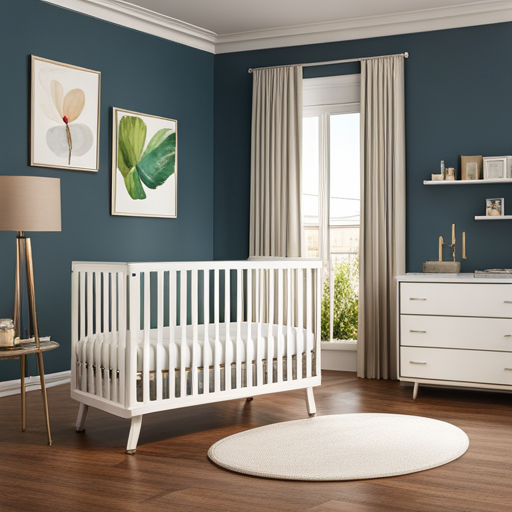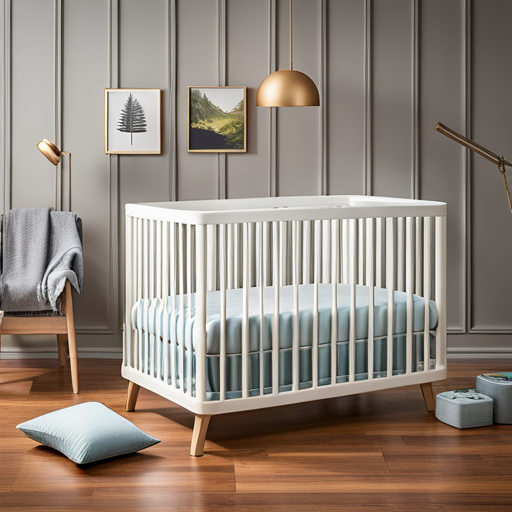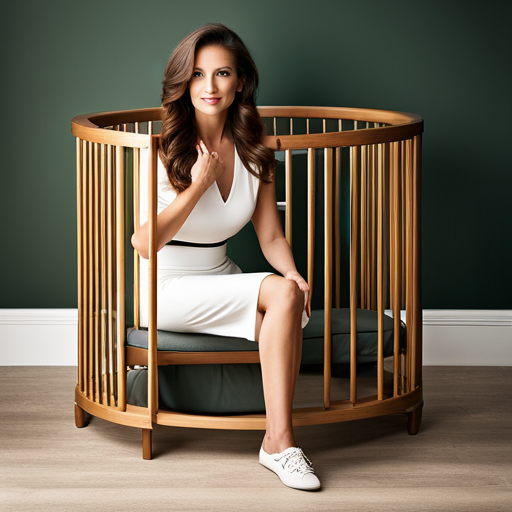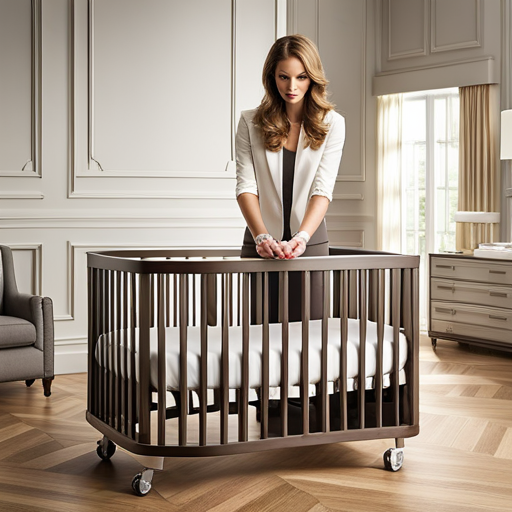"Cherishing Little Steps - A Haven for Baby and Family Journeys"
Safest Baby Crib
You want to provide the safest sleeping environment for your precious little one, don’t you? Well, look no further! In this article, we will guide you through the essential features to consider when choosing a baby crib.
From safety standards and mattress selection to assembly tips and maintaining a secure sleeping space, we’ve got you covered.
With our evidence-based advice and your dedication to your baby’s well-being, you can rest easy knowing you’ve found the safest crib for your bundle of joy.
Key Takeaways
- Safety standards for baby cribs have been updated to ensure the highest level of protection.
- When choosing a crib mattress, factors such as firmness and breathability should be considered.
- Essential safety features for baby cribs include meeting current safety standards, adjustable mattress height, and sturdy construction.
- When assembling a baby crib, it is important to follow the manufacturer’s instructions closely and check for loose or sharp edges after assembly.
Safety Standards for Baby Cribs

The safety standards for baby cribs have been updated to ensure the highest level of protection. It is crucial to consider the importance of crib safety when choosing a crib for your little one.
Baby crib recalls in recent years have highlighted the need for stricter regulations and improved safety features. These recalls were triggered by incidents where infants were injured or even killed due to faulty designs or hazardous materials used in the construction of cribs.
To address these concerns, organizations such as the Consumer Product Safety Commission (CPSC) have revised their guidelines to enhance crib safety. The new standards require stronger slats, sturdier hardware, and more stringent testing procedures to eliminate potential hazards. Additionally, manufacturers must now provide clear instructions on assembly and maintenance, ensuring that parents can properly set up and maintain their cribs.
By adhering to these updated safety standards, you can rest assured that your baby will be protected while sleeping or playing in their crib. Regularly checking for any recalls or product updates is also essential to stay informed about potential risks associated with specific brands or models.
Choosing the Right Crib Mattress

When choosing the right crib mattress, it’s important to consider factors such as firmness and breathability. The mattress should be firm enough to provide a safe sleeping surface for your baby, reducing the risk of Sudden Infant Death Syndrome (SIDS). Additionally, a breathable mattress allows for proper airflow and can help regulate your baby’s body temperature.
To assist you further in making an informed decision, here is a table comparing organic crib mattresses and waterproof crib mattresses:
| Organic Crib Mattresses | Waterproof Crib Mattresses |
|---|---|
| Made from natural materials like organic cotton or wool | Designed with a waterproof layer to protect against spills and accidents |
| Free from harmful chemicals, pesticides, and synthetic materials | Easy to clean and maintain |
| Provides a hypoallergenic sleeping environment for babies with allergies or sensitivities | May not be as breathable as organic options |
Organic crib mattresses are a popular choice among parents who prioritize using natural products for their little ones. These mattresses are made from organic cotton or wool, ensuring that no harmful chemicals or synthetic materials come into contact with your baby’s delicate skin. They also provide a hypoallergenic sleeping surface, making them suitable for babies with allergies or sensitivities.
On the other hand, waterproof crib mattresses offer convenience and ease of cleaning. They feature a waterproof layer that protects against spills and accidents. While they may not be as breathable as organic options, they still meet safety standards.
Ultimately, the choice between an organic or waterproof crib mattress depends on your personal preferences and priorities. It’s essential to select a mattress that provides both comfort and safety for your little one’s peaceful sleep.
Essential Safety Features for Baby Cribs

To ensure the safety of your little one, it’s crucial to look for cribs with essential safety features. With recent baby crib recalls and the importance of following crib safety guidelines, it’s more important than ever to choose a crib that will provide a safe sleeping environment for your child.
When searching for a baby crib, there are several key safety features you should consider. First and foremost, make sure the crib meets current safety standards set by organizations such as the Consumer Product Safety Commission (CPSC). Look for cribs that have been tested and certified to meet these standards.
Another important feature is adjustable mattress height. This allows you to lower the mattress as your baby grows and becomes more mobile. It helps prevent them from climbing or falling out of the crib once they start exploring their surroundings.
Additionally, make sure the crib has sturdy construction with no loose or sharp parts that could potentially injure your child. Avoid cribs with drop-side mechanisms, as they have been banned due to safety concerns.
Lastly, consider investing in a quality mattress that fits snugly in the crib without any gaps. This ensures that your baby won’t get trapped between the mattress and sides of the crib.
Tips for Assembling a Safe Baby Crib

Make sure you follow the manufacturer’s instructions closely when assembling your new crib to ensure it is safe for your little one. Assembling a baby crib may seem like a straightforward task, but there are common mistakes that many parents make during the process. By being aware of these mistakes and taking precautions, you can create a safe sleeping environment for your baby.
One important step before assembly is to check baby crib reviews. This will give you insight into the quality and safety features of the crib you have chosen. Look for cribs that meet current safety standards, such as those set by the Consumer Product Safety Commission (CPSC). Additionally, read customer reviews to learn about any potential issues or concerns regarding assembly.
When assembling the crib, take your time and carefully follow each step in the instruction manual. A common mistake is not tightening all screws properly, which can lead to instability and potential hazards. Make sure all parts are securely fastened before placing your baby in the crib.
Another mistake to avoid is using substitute parts or hardware that do not come with the crib. Each part of the crib has been specifically designed and tested for safety purposes. Using mismatched or incompatible parts can compromise its structural integrity.
Lastly, always double-check that there are no loose or sharp edges on any part of the crib after assembly. These can pose injury risks to your child.
Maintaining a Safe Sleeping Environment for Your Baby

Maintaining a safe sleeping environment for your little one is essential for their well-being and peace of mind. Creating a soothing sleep environment for your baby can greatly contribute to their overall sleep quality and promote better restful nights. To achieve this, there are a few key factors to consider.
Firstly, it is important to ensure that your baby’s crib meets all safety standards and guidelines. This includes checking the mattress size and firmness, as well as making sure that there are no loose or dangling cords near the crib that could pose a strangulation hazard.
In addition to the crib itself, establishing a consistent bedtime routine for your little one can also help create a calming atmosphere for sleep. This routine should include activities such as bathing, reading books, or singing lullabies, which can signal to your baby that it is time to wind down and prepare for bed.
Furthermore, maintaining an optimal room temperature and ensuring proper ventilation in your baby’s sleeping area can also contribute to a more comfortable sleep environment. Keeping the room dark with blackout curtains or shades can help block out any excessive light that may disrupt their sleep.
Frequently Asked Questions
How Do I Choose the Best Crib for My Baby’s Specific Needs and Preferences?
When choosing a crib for your baby, consider their sleeping preferences and needs. Look for features like adjustable mattress heights, sturdy construction, and safety certifications. Always prioritize safety to ensure a peaceful sleep environment.
Are There Any Additional Safety Precautions I Should Take When Using a Crib for Twins or Multiples?
Are there any additional safety precautions you should take when using a crib for twins or multiples? Ensuring a safe sleeping environment for active babies is crucial. Let’s explore some key measures to keep in mind.
What Are the Most Common Mistakes Parents Make When Assembling a Baby Crib, and How Can I Avoid Them?
When assembling a baby crib, common mistakes parents make include not reading the instructions thoroughly, using the wrong tools, and not tightening all the screws. Avoid these errors by carefully following the instructions and using the correct tools.
Can I Use a Second-Hand Crib and Still Ensure It Meets Safety Standards?
When deciding between a new or second-hand crib, it’s crucial to ensure safety for your baby. Check for up-to-date safety standards, proper assembly, and no recalls. Don’t compromise on your little one’s well-being.
Are There Any Specific Recommendations for Creating a Safe Sleeping Environment for a Baby Who Has Started Rolling Over or Moving Around in the Crib?
To create a safe sleeping environment for your baby who is rolling over or moving around in the crib, ensure the crib mattress fits snugly, follow crib safety standards, and remove any pillows or blankets that could pose suffocation risks.
Conclusion
In conclusion, when it comes to selecting the safest baby crib for your little one, there are several important factors to consider. By adhering to safety standards and choosing a firm mattress, you can ensure a secure sleeping environment for your baby.
Additionally, cribs with essential safety features, such as adjustable mattress heights and sturdy construction, provide added peace of mind. Remember to follow assembly instructions carefully and regularly check for any loose screws or parts.
It is interesting to note that according to a study by the American Academy of Pediatrics, babies who sleep in their own cribs have a lower risk of Sudden Infant Death Syndrome (SIDS) compared to those who share a bed with adults. This statistic highlights the importance of creating a safe sleeping space for your baby in their own crib.
By prioritizing safety at every step, you can give your little one the best start possible.


